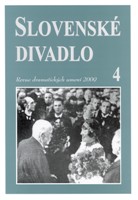K problematike postáv slovenskej drámy po roku 1990
The Problematics of Characters in the Slovak Drama after 1990
Author(s): Elena KnopováSubject(s): Theatre, Dance, Performing Arts
Published by: Ústav divadelnej a filmovej vedy SAV
Summary/Abstract: The common feature of the Slovak authors active in the 1990s appears to be the tendency towards the thematisation of periphery – writings about the prospects of decadents, outcasts, unstable individuals, members of so called lower classes, prostitutes, porn actresses, oddballs, fools, depicting fetishistic and antisocial behavior. Prominent representative of young Slovak theatrological generation states that the characters of Slovak drama after 1990 represent a whole complex of diverse individuals reduced from dramatic characters to standardized ones. And we cannot even talk about the solid or fixed dramatic types. Sometimes there are the realistic characters presented, or the characters based on the real life people, who are hyperbolized, banalized and mocked. Other times, these are replaced by a certain „live“ metaphors. Their physical appearance, a visual side of the characters, is not clearly established, rather they can be distinguished through their speech (pronounced replicas and the way they talk). The vast majority of the characters are neutral or negative, while positive figures are the exception. There are uncertain concepts lying in front of us, helpless torsos of the dramatic characters with just their thoughts left (unhierarchized, unsorted, unfinished) and the submissive position to something that govern their inner world and which is most often skepticism, nostalgia, biologism (instinctiveness). The characters are passive, there is not the slightest tendency to change the circumstances which they experience. Either they suffer as they try to adapt to their surroundings, from which they differ or they are not aware of their otherness, or try to manipulate their social environment (they don‘t search for solutions, only combine|, and thus no change is possible. Following the line hero - antihero – non- hero, we believe that most of the characters can be categorized as non-heroes. We define nonhero as a person who does not want even fight, neither hold any opinion or clearly articulate a position on, but also against anything (that is no longer against something). For such a character, passivity is becoming the only activity which is capable of, not that he chose it to demonstrate his personal opinion or attitude. From the long term perspective, as the transformation of the character to non-hero continued he has become unsustainable in the story of drama, which on the other hand have had an impact on the method of the author. The authors often put their characters straight into the constructed or pre-set situations that result in further changes, e.g. in the structure, concept, dialogues and the language of drama. Dramatic characters were replaced by ambivalent, unsolid and uncertain types. Uncertainty is often complemented with them fleeing into the virtual or unreal and parallel (sometimes dream) world that these characters merge with reality, or are melt in a different reality.
Journal: Slovenské divadlo
- Issue Year: 57/2009
- Issue No: 04
- Page Range: 253-269
- Page Count: 17
- Language: Slovak

